Gold prices rebound as risk-off mood grips markets
As the turn of the calendar occurred on Friday, the bull streak for the market since the April lows ended. Such was not unexpected, and the correction has been a topic of discussion in our #DailyMarketCommentary over the last two weeks. To wit:
“While the overall backdrop remains bullish, including stable economic growth and earnings, it is worth considering that markets don’t usually rise in a near-vertical line. It certainly happens historically, but they always eventually end, just when most begin to expect they won’t.”
Since the April lows, the bull streak has defied gravity. While there have been plenty of concerns from a debt downgrade by Moody’s to weakening economic data, tariffs, and a Fed remaining monetarily restrictive, the bull charge has been quite astonishing.
The speculative frenzy, driven by retail investors, was fueled by a cocktail of AI euphoria, abundant liquidity, and an insatiable appetite for risk. Consequently, the S&P 500 has enjoyed its third-longest streak of 3-year highs since 1928.
“What a year to be an investor. In pretty much anything, at pretty much any time. Even during the dog days of summer. It’s unusual for stocks to record so many multi-year highs in July. With a week left and helped by six straight record closes, the S&P 500 has already carved out a place in history as one of the best Julys ever. Only two other years have witnessed so many highs during a traditionally slow month.” – Sentimentrader.com
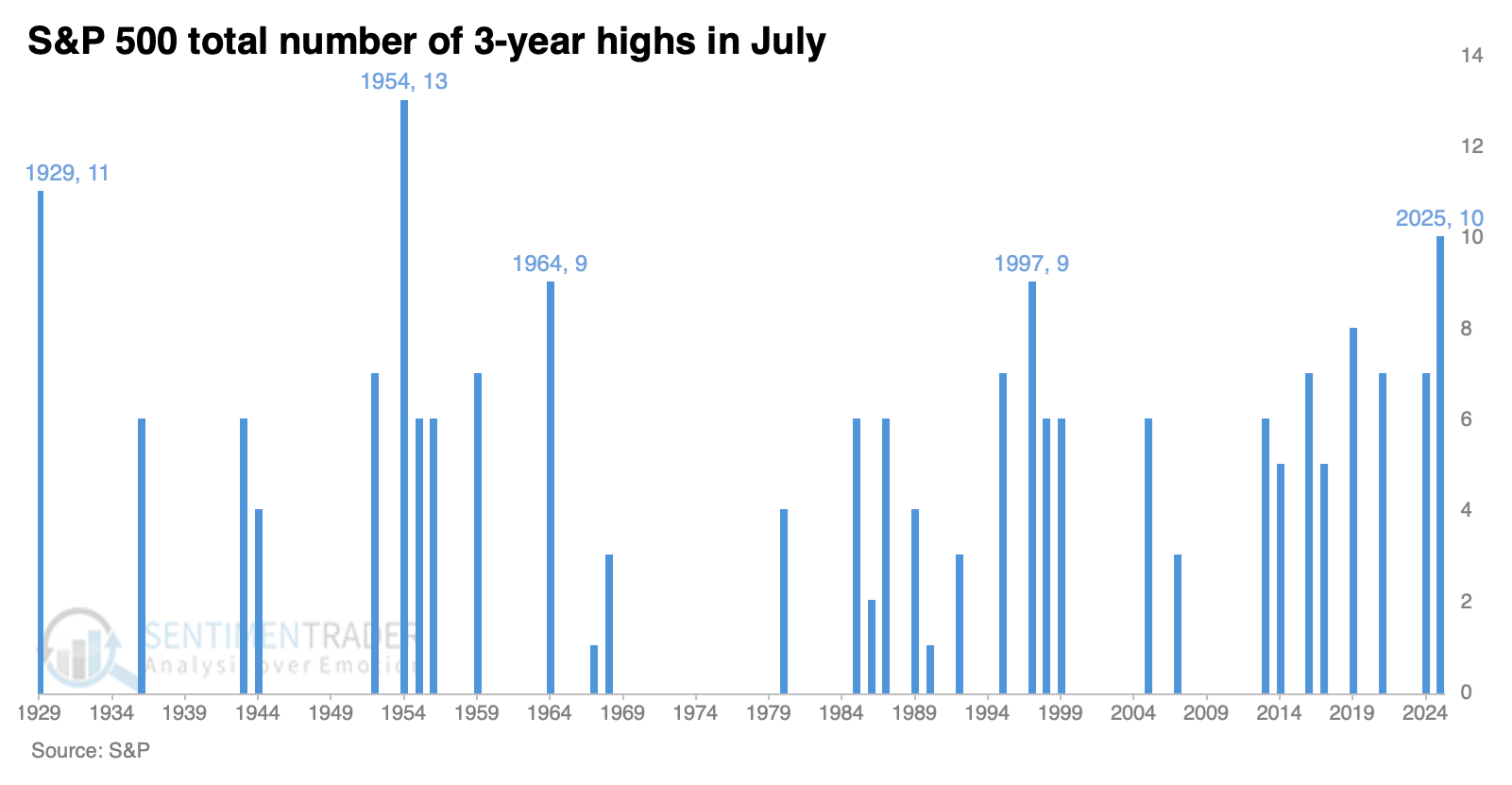
Simultaneously, Wall Street analysts have been busy raising earnings expectations, but the bull streak’s true undercurrent has been speculation. The latest earnings season saw “beats” primarily driven by cost-cutting and buybacks, not increasingly strong top-line revenue growth. More importantly, as noted in the #BullBearReport, valuations expanded as investors piled into anything tied to AI infrastructure, semiconductor supply chains, or cloud capacity.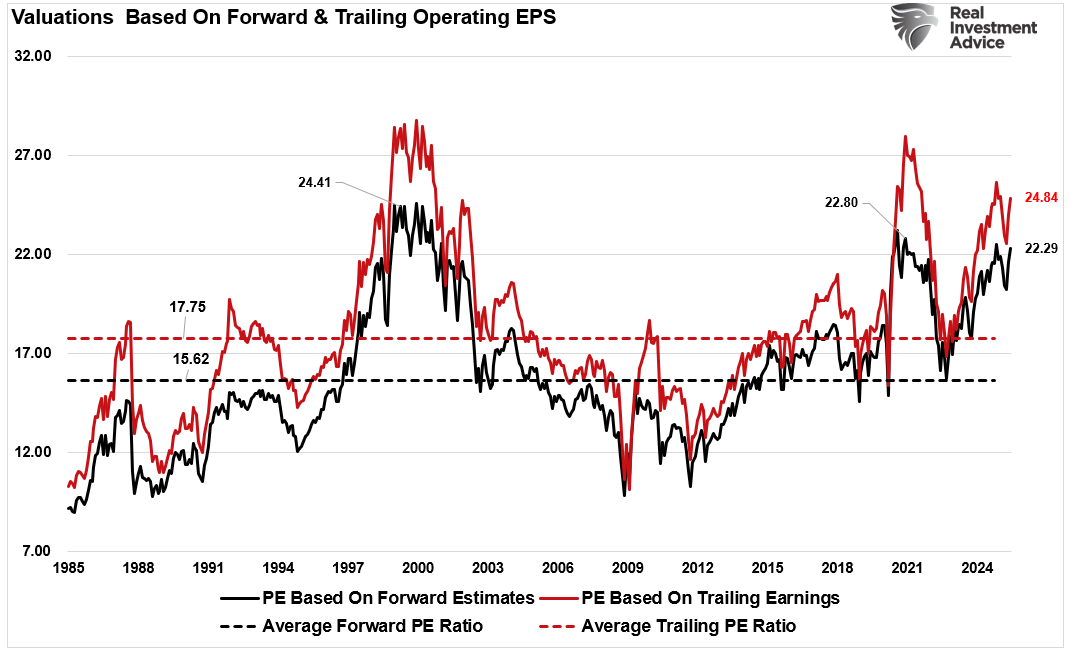
The Return Of FOMO
The fear of missing out (FOMO) has also returned with a vengeance. But what’s more concerning is the resurgence of meme stock mania. Stocks like Kohl’s and Dunkin Donuts saw explosive moves on no fundamental news. Speculative option bets, particularly zero-days-to-expiration (0DTE) options, from retail investors hit volume records, pushing the speculative trading indicator to more extreme levels.
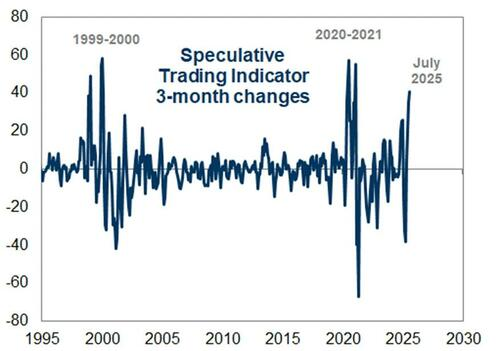
This isn’t a healthy sign of a broad-based bull market. Instead, it reflects a market driven by liquidity, leverage, and sheer momentum. In other words, we are once again in a “lottery ticket” market where risk management takes a back seat to gambling. History has shown that the house usually wins when market participants treat equities like casinos.
Sentimentrader concluded that momentum has been momentous for big, popular indices like the S&P 500 and Nasdaq Composite. As they note:
“That is usually a good sign, but a twist is when we’re seeing it. It has been relatively unusual to see such significant clusters of multi-year highs in these indices at this time of year. As we head into some of the lowest-volume trading of the year in August, it has usually proved to be a good time for traders to take profits and relax on the beach. None of this suggests a sell signal, especially beyond the next month or so. It does indicate that the upside may be limited as buyers relax after an impressive month.”
Let’s take a look at what likely happens next as August begins.
Technical Breakdown
From a technical perspective, the 20-DMA serves as a short-term bullish trend guide. During sustained rallies, it acts as a support level, and violations often signal a change in market character. The recent breach broke a 72-day win streak going back to 1965. As is always the case, such moves always end; the timing is tricky to know.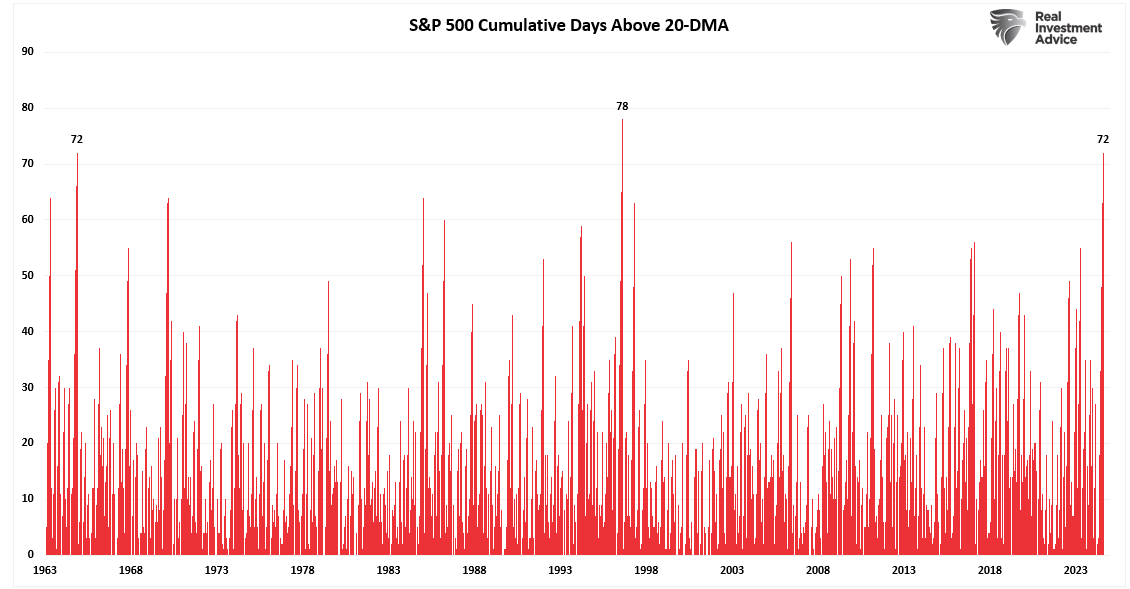
Furthermore, the break of that 20-DMA suggests an end to the bull streak and shifts attention to the following key supports:
- The 50-DMA (currently near 6,130 on the S&P 500) and
- The more critical 200-DMA (around 5,900).
More importantly, several key technical indicators are flashing caution. The Relative Strength Index (RSI) had been hovering near overbought territory above 70 for several weeks, but the sell-off has started to reverse that overbought condition back to neutral. Lastly, the Moving Average Convergence Divergence (MACD) triggered a “sell signal” indicating a potential shift from bullish momentum.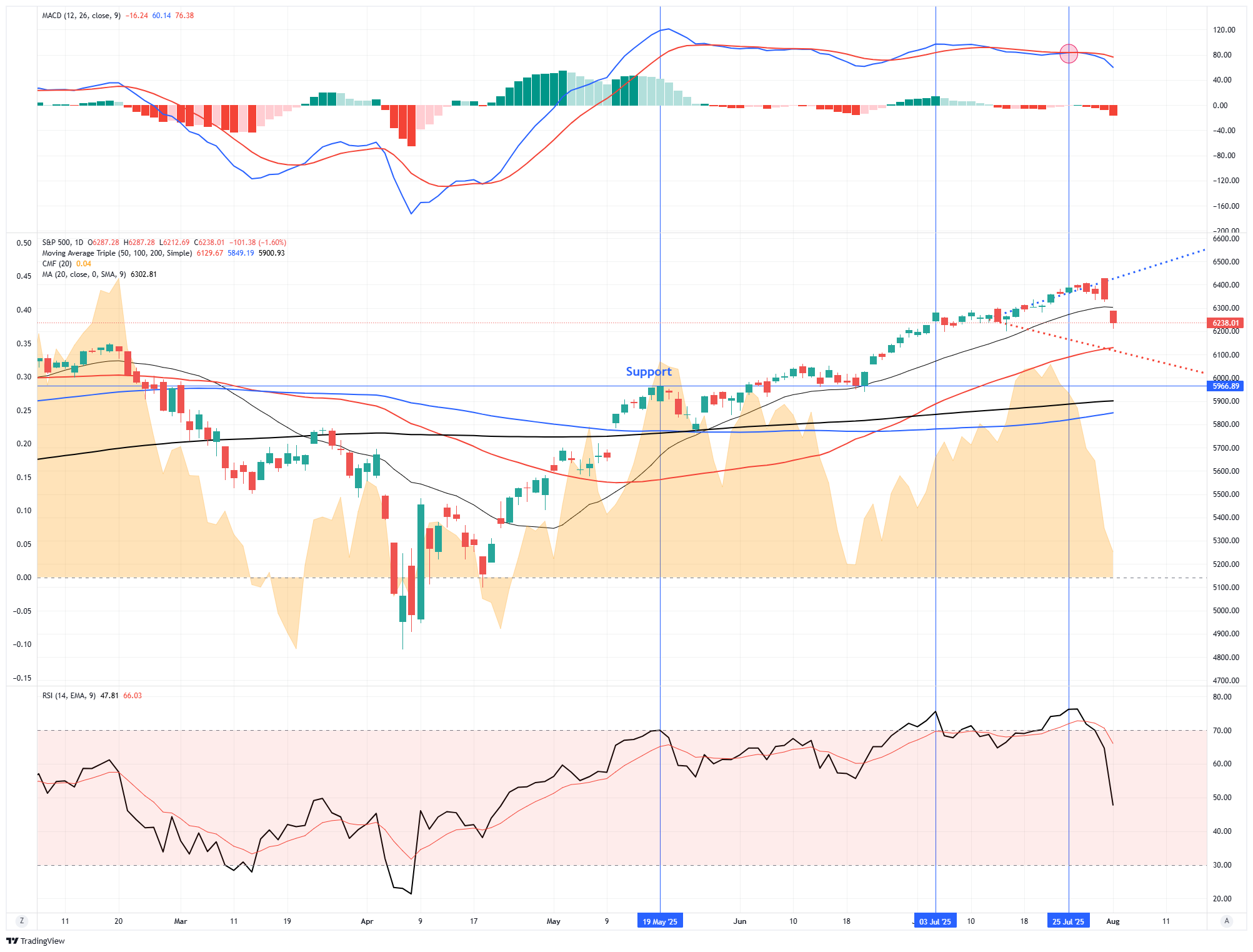
Breadth has also weakened; despite index strength, the rally has been led by a handful of mega-cap tech names while small caps and value stocks lag. Additionally, volatility indicators like the VIX, which were previously compressed, spiked on Friday.
As we discussed recently, the market had not had a +/-1% move in quite a long stretch. While such periods of complacency can last longer, investors should remember that low volatility tends to beget high volatility. These “buying stampedes” typically last on average about 15 trading days, so at 25 and counting, the risk of a +/- 1% had become quite elevated.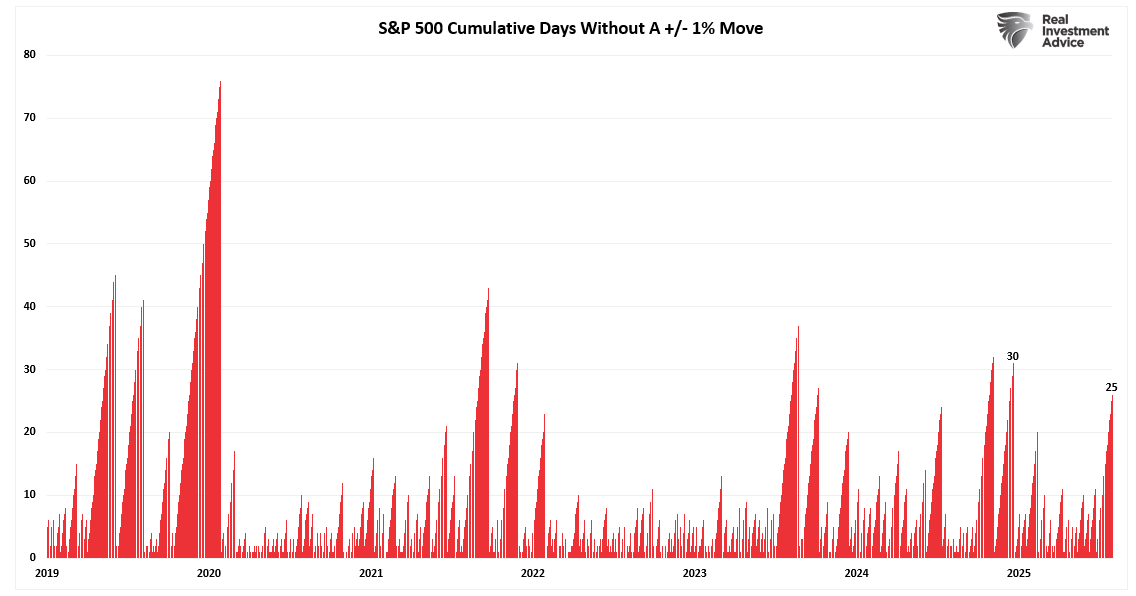
Taken together, these technical cracks suggest the market’s easy path higher may be ending, at least for now.
August Stats
As Sentiment Trader stated, the timing of this end to the bull streak is notable. August and September are historically the weakest months of the year for equities. Several factors contribute to this seasonal weakness. As earnings season winds down, the market loses a key catalyst for upside surprises. Trading volumes typically dry up in August as Wall Street heads to the Hamptons, and low liquidity often exacerbates volatility, especially when bad news hits.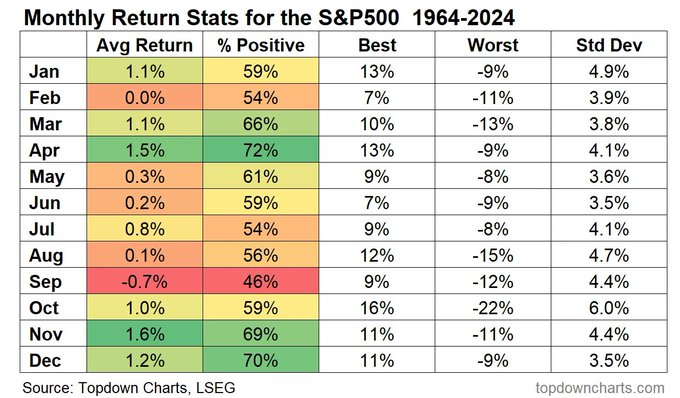
Economic uncertainty adds another layer of risk, with the Federal Reserve remaining steadfastly hawkish despite recent signs of disinflation. The unexpectedly weak labor print on Friday and the potential for weaker inflation prints next week could rattle markets further.
The bottom line is that 5-10% corrections are not uncommon during August-September, even within longer-term bullish trends.
Portfolio Tactics: Participate, But Manage Your Risk
Given this backdrop, investors need to shift from an “offense-only” mindset to a more balanced approach. While the broader bull market may still have legs into year-end, driven by liquidity and sentiment, the path over the next two months could be more volatile. As we concluded in this week’s newsletter:
“August has historically been a challenging month for investors. With markets often thinning out as Wall Street heads to the Hamptons, liquidity dries up, volatility picks up, and sentiment can shift on a dime. This year, the risk is compounded by overly optimistic earnings expectations, elevated valuations, and a growing divergence between macro reality and market pricing. While we’re not suggesting investors head for the exits, this is a time to be more tactical, not less. Here’s how we’re positioning ourselves in August:”
- Trim Into Strength – Markets have run hard since the April lows. Use rallies to rebalance if you’re sitting on gains in overweight positions, particularly in tech or AI-related names. Harvesting profits doesn’t mean you’re bearish; it means you’re managing risk.
- Raise Cash Marginally – We’re not calling for a crash, but a modest cash buffer gives you flexibility. With uncertainty rising around rate policy, earnings sustainability, and global headlines, having dry powder lets you take advantage of pullbacks rather than reacting emotionally.
- Tighten Stops & Reassess Risk – Review trailing stops and position sizes. If a stock has doubled or tripled, is the original thesis still intact, or is it momentum? Be honest about your risk exposure, particularly in high-beta areas.
- Broaden Exposure Beyond Tech – The market is increasingly narrow. Diversifying into sectors like healthcare, staples, or value, with more reasonable valuations and stable earnings, can help cushion volatility and provide balance.
- Focus on Quality & Free Cash Flow – With forward earnings optimism priced in, now’s the time to focus on companies with actual free cash flow, low debt, and pricing power. These businesses are better positioned if economic growth stalls.
- Watch the Yield Curve and Credit Markets – Bond markets tend to sniff out trouble before equities. If spreads begin to widen or the yield curve steepens from the short end, it’s a warning that the current market complacency may not last.
The break of the 20-DMA after such a historic streak isn’t a standalone red flag. However, within the context of rising speculative excess, narrowing breadth, and seasonal weakness, it’s a signal investors shouldn’t ignore. The market’s narrative of “AI-fueled growth forever” has become increasingly detached from economic realities.
Expect volatility to rise and sentiment to get tested in the near term. This environment offers opportunity for disciplined investors, but only if risk is managed appropriately. As always, it’s not about being bullish or bearish, but about understanding where you are in the cycle and adjusting accordingly.
The market may continue to rise, but the margin for error is shrinking, and risk is best managed before it shows up in your P&L.
